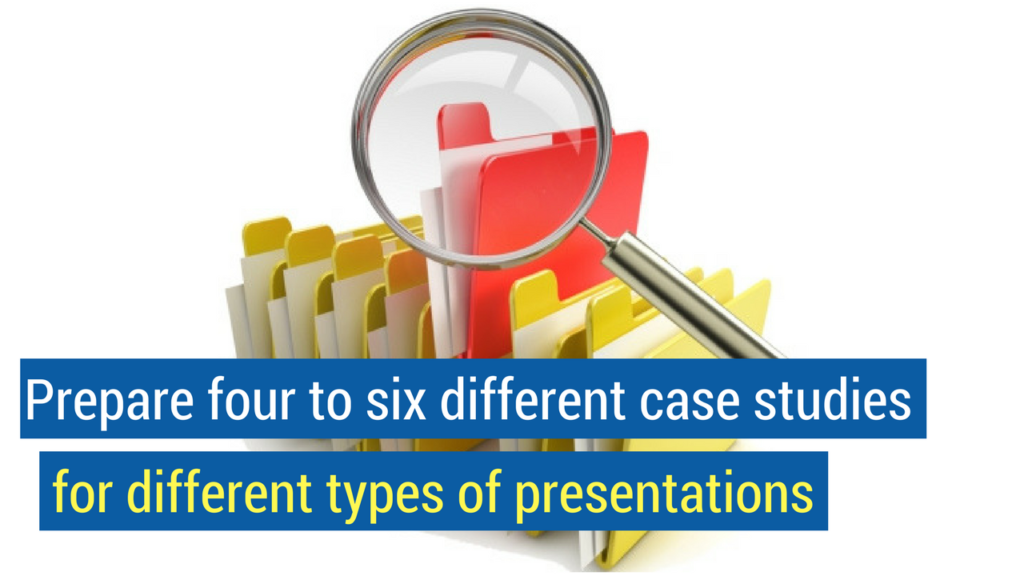
The case study presentation is king! If there’s ever been a piece of outdated, old-school sales advice, it’s this: “You really need to give a features and benefits presentation!”
Have you ever been given this advice? I know I have! Countless sales gurus told me this when I first began selling.
I’d start by explaining a feature of my product, such as “My product is made of titanium.” Then, I’d relate the benefit of that feature, as in “Because it’s titanium, it’s super strong and will last three times longer than the competition while weighing half as much!”
This was a classic feature-benefit presentation—and it will no longer work in today’s marketplace.
If you want to dramatically improve your sales technique today, it’s time to leave this approach in the rearview mirror.
Now, it’s all about the case study presentation.
In this video and article, I’m going to show you exactly how to implement a case study presentation into your selling strategy.
Why It’s Time to Replace Feature and Benefit Selling with a Case Study Presentation

Craft your sales presentations around your prospect’s biggest challenges.
Feature and benefit selling was first developed in 1887—that’s well over 100 years ago!
At the time, it was a revolutionary sales approach. But, unfortunately, it hasn’t changed much since then.
While the feature and benefit approach to selling was effective for many decades—maybe even a century—it’s time to acknowledge that this approach is outdated today.
Prospects have heard feature and benefit presentations from your competitors a thousand times.
They expect you to use this approach, and when you do, it’s perceived as boring and uninspiring.
Why? Because it’s all about you, not them.
Prospects want you to care about what they care about—namely, themselves and their biggest challenges.
A features and benefits presentation tells them that you only care about pushing your product or service and closing a deal.
A case study presentation, on the other hand, invites prospects to be part of a story where—with your help—they can solve their biggest challenges and reach their goals as an organization.
If you want to increase your sales, it’s high time to toss the features and benefits presentation and start using the case study presentation instead.
Read on to discover the must-know keys to any great case study presentation.
#1: People want results and stories, not features and benefits.

Ask questions frequently in your sales presentation to get feedback throughout the meeting.
In case no one’s told you, sitting through a presentation about features and benefits is about as exciting as reading a high school textbook.
It’s dry, it’s impersonal, and it doesn’t engage prospects.
Prospects don’t want to hear the features and benefits of your offering. Instead, the strongest sales presentations show them stories of the results your customers have seen.
Once they can see how you’ve turned things around for other customers, they’ll be more interested in seeing how you can turn things around for them, too.
Case study presentations are designed to share stories that relate to your prospect’s situation. As a result, they’re the best way to show that you truly understand your prospect’s pain.
This also gives you the opportunity to share results you’ve achieved without coming across as salesy.
A case study presentation is basically a fancy way of telling your prospects stories of other clients that you’ve had that were similar to them. If you can master it, you’ll be adding a critical selling skill to your strategy.
It doesn’t have to be complex.
And, as you’ll see in the next tip, it can actually be formulaic and still be relatable to your prospect.
#2: Prepare four to six different case studies for different types of presentations.

Know who your ideal prospect is, and disqualify those who aren’t a good fit.
Not all prospects are exactly alike.
If you’re like most organizations, you probably have a few different types of ideal clients.
Let’s say that you have two really distinct types of clients. That means you should have at least two case studies for each type of client.
In other words, you’ll want to prepare four case studies to use in your case study presentation to get started.
This doesn’t have to be laborious or take that much time.
Instead, just dig into your client list and create a list of your top few success stories.
These should be organizations or people that you really helped accomplish something special.
Look for examples that represent each of your distinct types of clients so that you’ll have a relatable story for any qualified prospect.
By the way, don’t feel like you have to use the company’s name. It’s not a necessity.
Instead, check out the next tip to see what really matters most in your case study presentation.
#3: Be sure to really focus on the challenges and results.

Remember to focus on what the prospect cares most about—themselves and their challenges.
The most important part of any case study presentation is the list of challenges that your past clients have faced.
Briefly describe what you did for those clients, and explain the results they accomplished as a result of working with you.
By breaking down each case study this way, you now have a compelling story to tell during your presentation.
Any case study presentation you give shouldn’t need more than two case studies.
All it takes is two case studies to create a powerful flow to lead the prospect through your presentation, and on to a successful close.
Remember, the results you share should be specific.
Give real numbers in your case study presentation, like, “Increased revenue by 24%” or, “Decreased employee turnover by 31%” or, “Increased customer retention by 11%.”
By giving these specific stats in the context of a relatable story, you’ll keep prospects engaged and really drive home the power of the results you’ve achieved.
#4: Relate the case studies presentation to your prospect’s situation.

Having a handful of case studies prepared will allow you to choose a couple that relate to your prospect on the spot.
Now that you’ve selected a few customer stories to share in your sales presentation, it’s time to use them in your case study presentation.
The key is to do this in a way that relates them to your prospect’s current situation.
This might sound something like, “George, let me share with you an example of another client that had a similar set of issues to you.
They were dealing with X, Y, and Z. Much like we’re discussing with you, we came in and developed A, B, and C.
As a result of that work, they were able to increase top-line revenues by 12% and profits by 18% in the first year.”
Be sure to use case studies about customers that faced the same challenges your prospect is facing.
69% of buyers said that salespeople could create a positive selling experience by listening to their needs, so start your case study presentation with a thorough discovery conversation where you do more listening than talking.
Once you’ve uncovered your prospect’s biggest challenges, share the case studies that will be most relevant to their experiences.
This will make you look like the knowledgeable expert you are—without boring your prospects with yet another features and benefits presentation.
Close More Sales with a Case Study Presentation

Update your sales presentation with case studies to crush your sales goals.
Because a features and benefits presentation feels like a boring monologue, it’s nearly impossible for salespeople to tell if they’re on the same page as their prospects throughout the sales meeting.
You may feel like everything is on the right track, just to get to the end and hear an objection you didn’t see coming.
A case study presentation, on the other hand, keeps you and your prospect in an engaging conversation, which will ultimately lead you to close more sales.
Start by remembering that prospects care more about results and stories than features and benefits.
Case studies are a great way to “show, don’t tell” what you can accomplish.
Second, prepare four to six case studies for your two or three different types of clients.
This is the secret to balancing the comfort of a prepared presentation with the excitement of a customizable conversation.
Third, remember to focus on challenges and results.
If you can’t share the name of a client in your case study, don’t sweat it.
What prospects really care about is how you’ve solved challenges like theirs—so share specific results and don’t worry about the rest.
Finally, remember to relate your case study presentation to your prospect’s situation.
Your offering is likely designed to solve a handful of particular challenges.
Once you discover which challenge a prospect faces, share case studies that will relate most to them.

This is critical to showing what you bring to the table without coming across as salesy.
These four must-know keys are all it takes to replace your outdated features and benefits selling with an engaging and modernized case study presentation.
Now that you’ve seen these sales presentation tips, I want to hear from you.
How have you approached presentations in the past? Be sure to share below in the comments section and join the conversation.

Hi Marc,
I just left a voice mail message for you regarding permission to use some of the contend and examples for my presentation of sales course. I am an instructor at UCLA Extension and a Distinguished Instructor teaching principles of marketing and ethics. I am preparing a short 2 1/2 lecture and PPT on Professional Selling and your website very good and inspiring articles, etc.
As always, I note your website and article on each slide.
Thank you,
Mark Stern